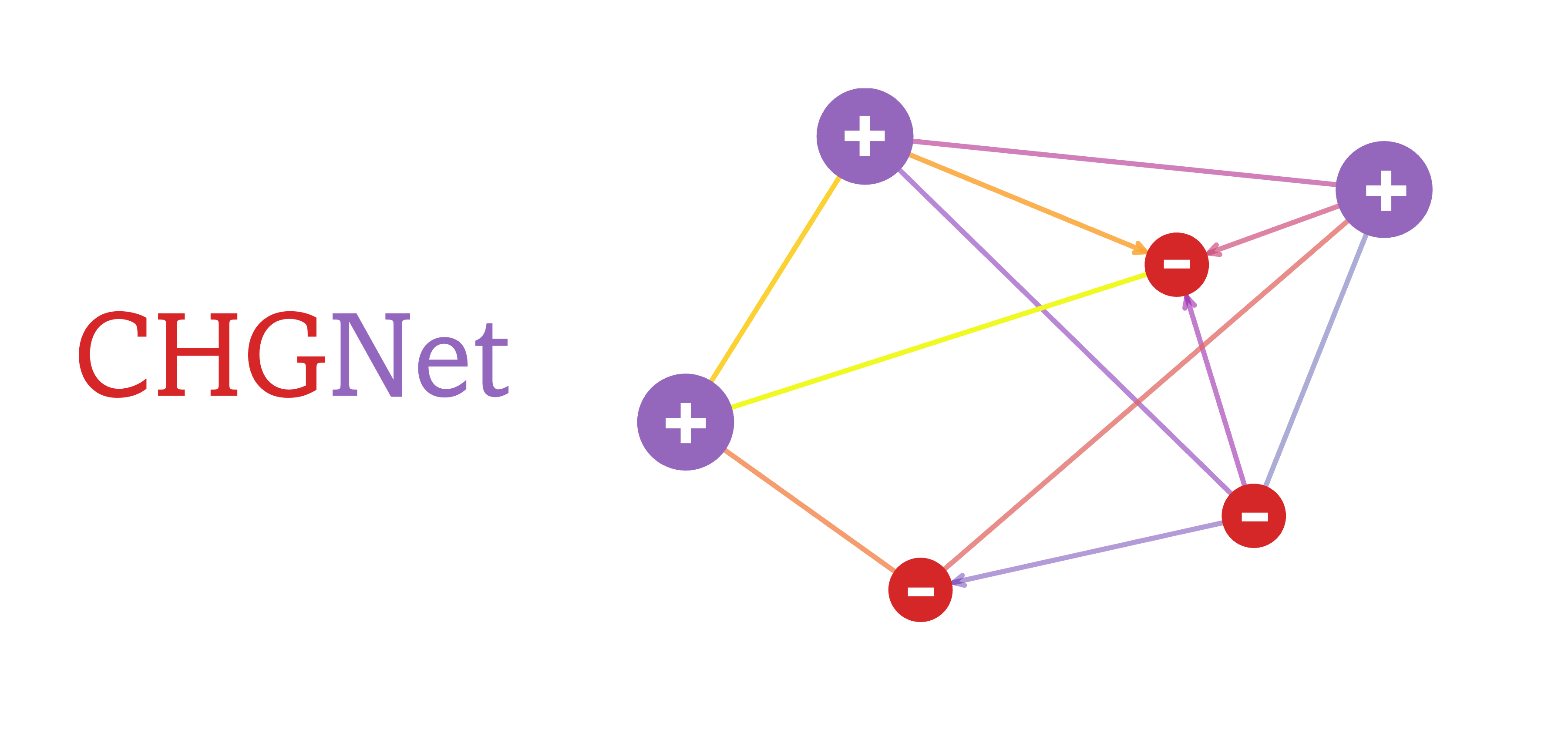A pretrained universal neural network potential for
charge-informed atomistic modeling
 Crystal Hamiltonian Graph neural Network is pretrained on the GGA/GGA+U static and relaxation trajectories from Materials Project,
a comprehensive dataset consisting of 1.5 Million structures from 146k compounds spanning the whole periodic table.
Crystal Hamiltonian Graph neural Network is pretrained on the GGA/GGA+U static and relaxation trajectories from Materials Project,
a comprehensive dataset consisting of 1.5 Million structures from 146k compounds spanning the whole periodic table.
CHGNet highlights its ability to study electron interactions and charge distribution in atomistic modeling with near DFT accuracy. The charge inference is realized by regularizing the atom features with DFT magnetic moments, which carry rich information about both local ionic environments and charge distribution.
| CHGNet_examples | Minimal examples for loading pre-trained model, predicting energy, force, stress, magmom as well as running structure optimization and MD. | |
| crystaltoolkit_relax_viewer | Plotly Dash app built with Crystal Toolkit that visualizes atom positions, energies and forces of a structure during CHGNet relaxation. |
CHGnet is not on PyPI yet. We plan to publish it as a package once the API has matured. For now, please install chgnet from source:
pip install -U git+https://github.com/CederGroupHub/chgnetor for an editable source install from a local clone:
git clone https://github.com/CederGroupHub/chgnet
pip install -e ./chgnetPretrained CHGNet can predict the energy (eV/atom), force(eV/A), stress (GPa) and magmom (muB) of a given structure.
from chgnet.model.model import CHGNet
from pymatgen.core import Structure
chgnet = CHGNet.load()
structure = Structure.from_file('examples/o-LiMnO2_unit.cif')
prediction = chgnet.predict_structure(structure)
print("CHGNet predicted energy=", prediction['e'])
print("CHGNet predicted magmom=", prediction['m'])Charge-informed molecular dynamics can be simulated with pretrained CHGNet through ASE environment
from chgnet.model.model import CHGNet
from chgnet.model.dynamics import MolecularDynamics
from pymatgen.core import Structure
structure = Structure.from_file("examples/o-LiMnO2_unit.cif")
chgnet = CHGNet.load()
md = MolecularDynamics(
atoms=structure,
model=chgnet,
ensemble="nvt",
compressibility_au=1.6,
temperature=1000, # in K
timestep=2, # in femto-seconds
trajectory="md_out.traj",
logfile="md_out.log",
loginterval=100,
use_device="cpu", # use 'cuda' for faster MD
)
md.run(50) # run a 0.1 ps MD simulationVisualize the magnetic moments after the MD run
from ase.io.trajectory import Trajectory
from pymatgen.io.ase import AseAtomsAdaptor
from chgnet.utils.utils import solve_charge_by_mag
traj = Trajectory("md_out.traj")
mag = traj[-1].get_magnetic_moments()
# get the non-charge-decorated structure
structure = AseAtomsAdaptor.get_structure(traj[-1])
print(structure)
# get the charge-decorated structure
struct_with_chg = solve_charge_by_mag(structure)
print(struct_with_chg)CHGNet can perform fast structure optimization and provide site-wise magnetic moments. This makes it ideal for pre-relaxation and
MAGMOM initialization in spin-polarized DFT.
from chgnet.model import StructOptimizer
relaxer = StructOptimizer()
result = relaxer.relax(structure)
print("CHGNet relaxed structure", result["final_structure"])Fine-tuning will help achieve better accuracy if a high-precision study is desired. To train/tune a CHGNet, you need to define your data in a
pytorch Dataset object. The example datasets are provided in data/dataset.py
from chgnet.data.dataset import StructureData, get_train_val_test_loader
from chgnet.trainer import Trainer
dataset = StructureData(
structures=list_of_structures,
energies=list_of_energies,
forces=list_of_forces,
stresses=list_of_stresses,
magmoms=list_of_magmoms,
)
train_loader, val_loader, test_loader = get_train_val_test_loader(
dataset, batch_size=32, train_ratio=0.9, val_ratio=0.05
)
trainer = Trainer(
model=chgnet,
targets="efsm",
optimizer="Adam",
criterion="MSE",
learning_rate=1e-2,
epochs=50,
use_device="cuda",
)
trainer.train(train_loader, val_loader, test_loader)- The energy used for training should be energy/atom if you're fine-tuning the pretrained
CHGNet. - The pretrained dataset of
CHGNetcomes from GGA+U DFT withMaterialsProject2020Compatibility. The parameter for VASP is described inMPRelaxSet. If you're fine-tuning withMPRelaxSet, it is recommended to apply theMP2020compatibility to your energy labels so that they're consistent with the pretrained dataset. - If you're fine-tuning to functionals other than GGA, we recommend you refit the
AtomRef. CHGNetstress is in unit GPa, and the unit conversion has already been included indataset.py. SoVASPstress can be directly fed toStructureData- To save time from graph conversion step for each training, we recommend you use
GraphDatadefined indataset.py, which reads graphs directly from saved directory. To create saved graphs, seeexamples/make_graphs.py. - Apple’s Metal Performance Shaders
MPSis currently disabled until a stable version ofpytorchforMPSis released.
link to our paper: https://doi.org/10.48550/arXiv.2302.14231
Please cite the following:
@article{deng2023chgnet,
title={CHGNet: Pretrained universal neural network potential for charge-informed atomistic modeling},
author={Bowen Deng and Peichen Zhong and KyuJung Jun and Kevin Han and Christopher J. Bartel and Gerbrand Ceder},
year={2023},
eprint={2302.14231},
archivePrefix={arXiv},
primaryClass={cond-mat.mtrl-sci}
}CHGNet is under active development, if you encounter any bugs in installation and usage,
please start an issue. We appreciate your contributions!


